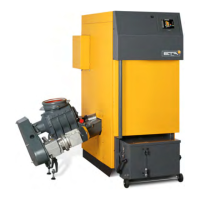Wood that has been stored in damp conditions for a l
ong time (10 years) has lost up to 50%
of its heating value.
Chips from such wood significantly reduce the achiev
able boiler output.
The final product from wet wood is compost, which ca
n be disposed of in a refuse incinerator but can hardly
be burned in a normal boiler.
Ensure good ventilation during storage.
The higher the water content of the wood, the more c
oarsely it should be chopped.
Never store more than a year's supply of wood chips
(round logs can be stored more easily and densely).
Be very careful where wood chips from waste wood a
re on offer at especially low prices; the fraction of dec
ayed material and perhaps also the amount of foreign
objects (nails, wood preservatives, sand, stones) can
be very high.
9.2 Moist fuel
Decay and mould
Up to a water content of approx. 25%, the water is
bound up in the wood fibres. Above 25%, water is
found between the fibre cells in cavities and capillary
vessels. This unbound water is a habitat for, and also
a basis for the reproduction of, microbes and fungi,
which can penetrate the tree through wounds in the
wood structure, particularly cuts or breaks. These
microbes convert cellulose and lignin into the basic
building blocks carbon dioxide and water. The wood
rots, hollows out and becomes brittle, ultimately losing
all of its heating value.
When a tree is felled, the race between drying and
decay begins. As the water content decreases, the
living conditions for microbes worsen until they die off
when the water content drops below 25%. The faster
the drying process, the more heating value remains in
the wood.
For thin branches, the microbes have a very large
contact surface in relation to the wood volume. No
matter how neatly the branches are stacked, losses in
heating value over 25% are the rule (and considerably
more in wet weather). This is why forestry businesses
don't even take part in this race when branches are
smaller than 3 to 5 cm; instead, the material is left
behind as nutrient material for the forest.
Easy recognition of moist or dry wood
Even through professionals who work daily with wood
chips only trust the oven test for measurements of the
exact water content, there is still a very simple way to
distinguish moist from dry. Chips that feel dry in the
hand have a water content below 25% and can be
stored without problems. If they feel wet, the water
content is sure to be above 35%.
If the wood chips are dark brown, light and already
crumbly, then you are holding rotten wood in your
hands, wood that has already lost the majority of its
heating value. From such "compost" you can expect
only problems, but not boiler output.
Do not store moist wood chips without ventilation
Wood chips can only be stored without ventilation (for
example in a concrete cellar) if their water content is no
more than 30%.
If moist wood chips from a sawmill are to be used
anyway, then no more than three weeks' supply should
ever be kept in an unventilated bunker. An air inlet and
an outlet fan can remove water vapour and at least
limit mould growth.
Store moist wood chips in an open hall
During the decay process, moist wood chips release
heat that drives out water. Wet areas form on the
surface, and rising water vapour may also be visible. If
the wind is given the chance to transport the water
away, coarse wood chips will dry while decay and fungi
will stay within acceptable limits.
Best is a flying roof separate from living and working
quarters, which keeps rain out but lets the wind work
unhindered. At least one side of the storage hall should
be completely open. Additional openings in all other
walls improve the storage conditions.
9.3 Drying and chopping wood chips
Coarse wood chips with minimal fine content dry
fastest
Coarse chips (chopped with sharp blades!!!) dry faster
with less loss of material due to the improved air circu-
lation. Fill heights between 4 and 6 m have proven
effective. This height is also safe as regards self-
ignition, which only becomes a danger at heights of 8
m or more.
Even when coarsely chopped, very moist and green
material (leaves and needles) and bark have a high
fine content (typical and unavoidable features of
shrubbery cuttings and delimbing material) and higher
biological activity, and allow only minimal air circula-
tion. In spite of higher self-heating, the low air
circulation slows the drying process and material loss
is considerably higher.

